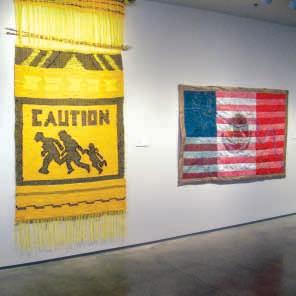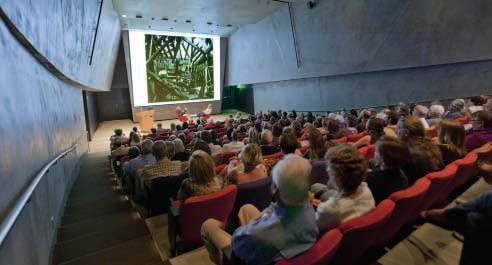
4 minute read
Art of the State
from March 5, 2015
Mother lands
Consuelo Jimenez Underwood
Advertisement
“I want to show the rage of the land,” said Consuelo Jimenez Underwood. by Josie Luciano From a distance, her art is a thing of beauty. But under the surface, the artist’s murals, quilts and woven rebozos belie the cultural agitation and environmental consequences that come with imposed borders. As an immigrant who spent her childhood on both sides of the U.S.-Mexican border, Underwood grew up crossing the country line on a daily basis to attend school in the states, travel back to her home in Mexico, and straddle the theninvisible boundary to pick seasonal crops with her family. consuelo Jimenez Now in her 60s, Underwood debuts underwood’s exhibit, her first museum exhibit in this state at the Mothers—the art of seeing, is on display at the nevada Museum of Nevada Museum of Art, using textiles to turn the borderlands of her childhood into art through May 3. For conceptual spaces where questions about more information, visit identity, disinheritance and ecological www.nevadaart.org. regeneration can take root. In her mural “Mountain Mama Borderline Blues,” the artist depicts the 1,950-mile-long boundary between Mexico and the U.S. with a jagged red line. This line is set against a backdrop of the Sierra Nevada range, showing that the reach of the wall extends far beyond the states that border Mexico. Giant cloth flowers sprout to the North and South, representing the “undocumented flowers that grow on both sides.” To Underwood, these flowers are the young people, “the ones who are going to inherit the desert; the ones who are going to inherit the heat that we are creating.”
This environmental devastation is an often overlooked consequence of the boundary. Kim Vacariu, Western Director of the Wildlands Network, points out the impacts that borderlands fragmentation have on native wildlife and people, “When [countries] build walls, they do not pay attention to the arroyos, washes, and streams, so when it rains the washes fill up and divert water from natural watersheds.” It is all too common to see migratory corridors and towns split by the wall, causing a loss of diversity for animal populations and flooding in human communities.
Beyond the scars on the land, Underwood captures the cultural fallout of the border with one iconic image that is repeated throughout several pieces in the exhibit. The image is that of the “border crossing sign” that dotted the highways of San Diego in the late 1970s. Resembling an animal-crossing marker, the graphic depicts the silhouettes of a father, mother, and child running across the street. In her piece “See Jane Run,” Underwood screenprints this image onto 120 pieces of cutout clothing, paying homage to the unidentified illegals who were killed while crossing highways during immigration.
In another textile, called “Run Jane Run,” Underwood appropriates the crossing sign image into a woven wall hanging, using construction tape and barbed wire alongside traditional fibers to create a life-size warning that simply reads, “CAUTION.” The rage of the land is a bit more subdued in Underwood’s hybrid flags. Created by superimposing the U.S. stars and stripes over the Mexican flag, stitch by stitch, these flags portray a dual identity that is both visually confusing and plainly beautiful as it hangs on the white gallery wall.
Underwood is well aware of the tendency to downplay traditional weaving, but has come to terms with her role in the borderlands issue.
“I just want to be a footnote,” she said. “I just want to be the person who said something with thread in the Southwest about the land.” Ω
Photo/Josie Luciano Consuelo Jimenez Underwood's textile works are display at the Nevada Museum of Art.
WANT TO PAY LESS ON YOUR AUTO LOAN?
ACT TODAY! ESTIMATES MINUTE
2



On average, people who refi nance and pay less at United Federal Credit Union reduce their monthly payment by $35!1 In just 15 minutes, discover how much lower your car payment could be! 2

Films at #NevadaArt presents
The Immortalists Sunday, March 8 / 3 pm
The story of two eccentric scientists obsessed with finding eternal youth
$7 / $5 Museum Members
Call or visit a branch today!
(888) 982-1400 | www.unitedfcu.com
Federally Insured by NCUA. Equal Opportunity Lender. Loan and payment terms subject to credit review and approval. Rates, terms and conditions subject to change without notice. [1] Members who refi nanced auto loans via the UFCU Universal Auto program 1/1/2014-11/11/2014 and whose monthly payment was reduced experienced an average payment reduction of $35 per month. [2] Actual savings calculation not available without application. Estimated savings may be provided based on supplied credit information and are subject to credit review and approval. Any estimates provided are not fi rm offers of credit and actual terms may vary. 15-minute duration not guaranteed. 021815-1-A
Donald W. Reynolds Center for the Visual Arts | E. L. Wiegand Gallery 160 West Liberty Street in downtown Reno | 775.329.3333 | nevadaart.org










